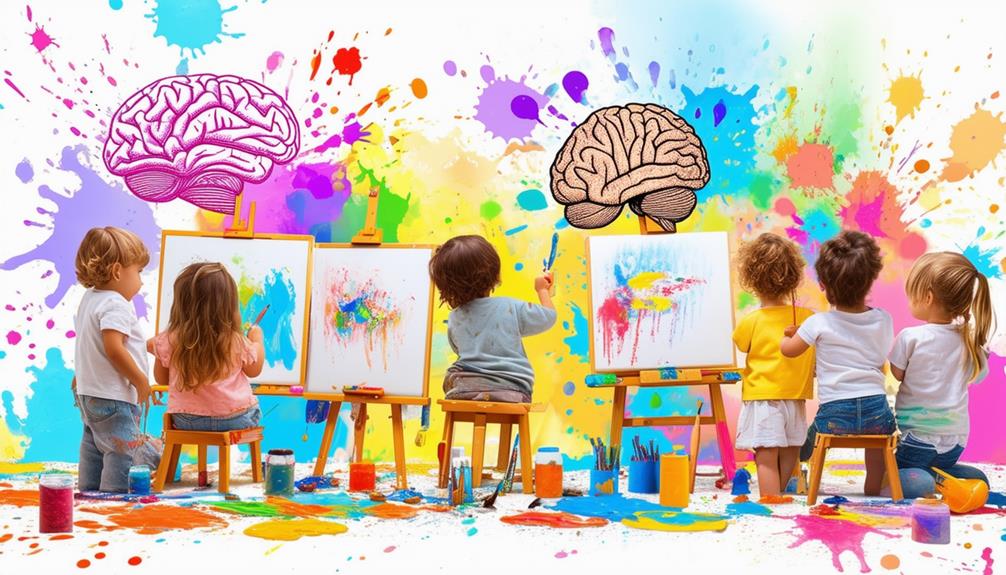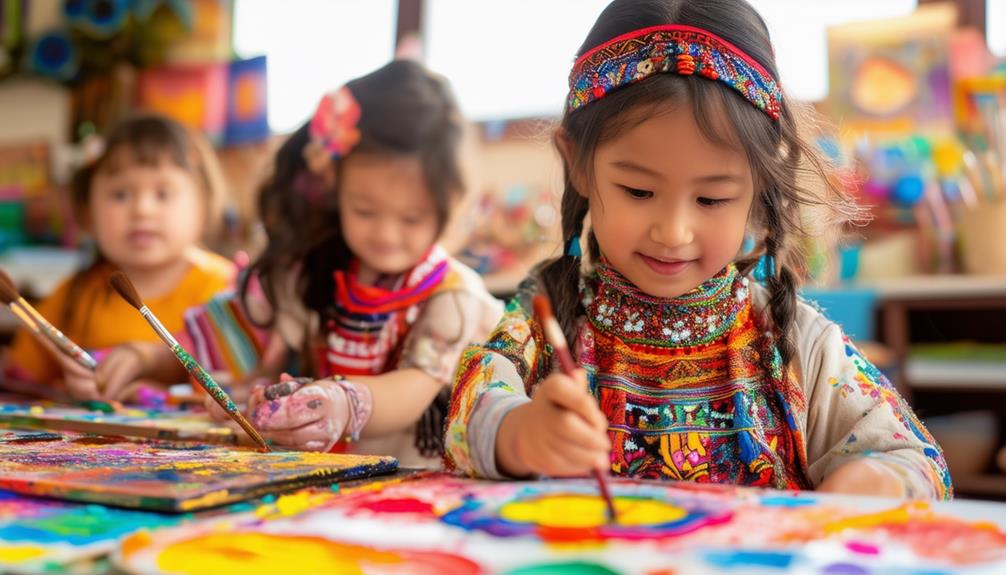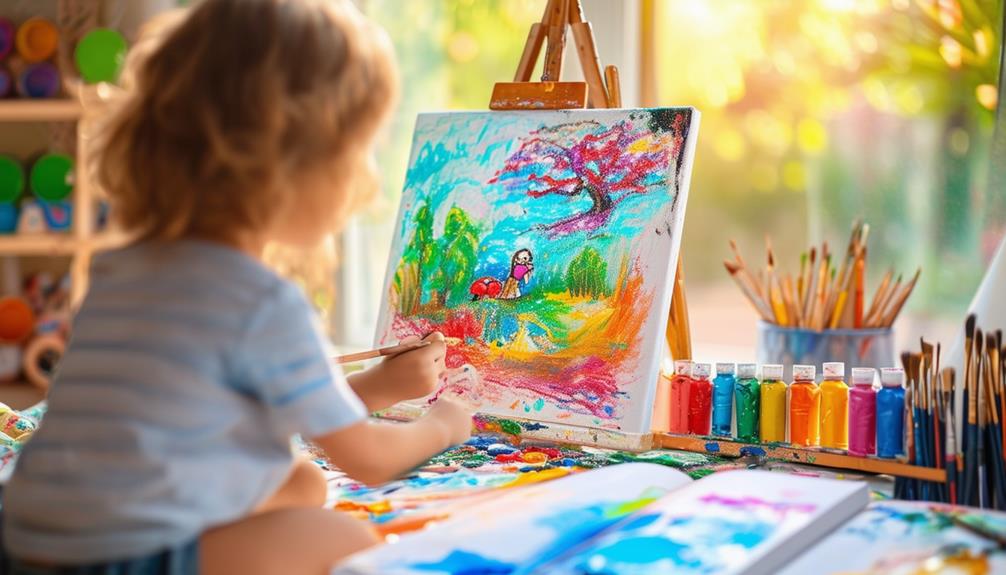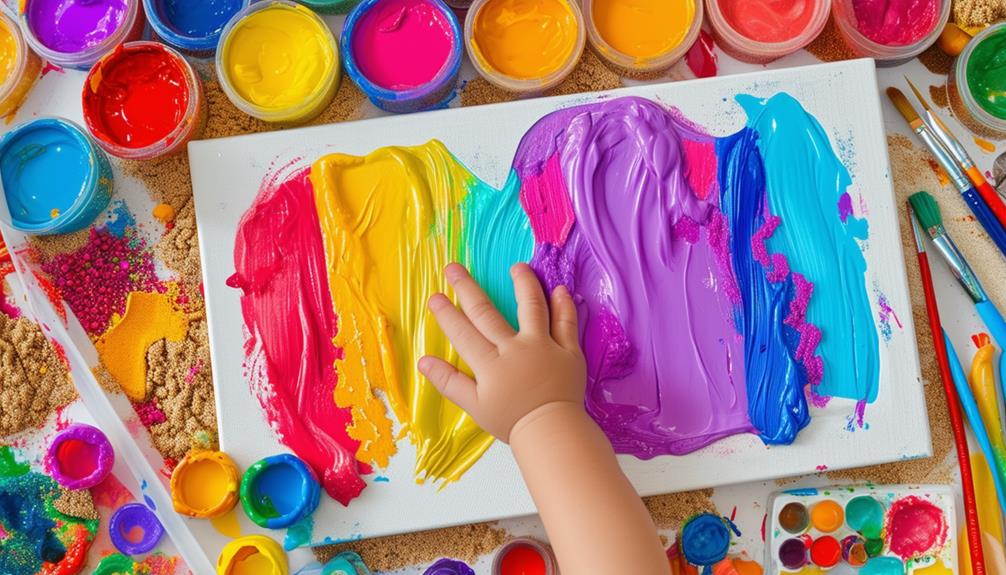Using Playdough for Fine Motor Skills Development

Playdough is an excellent tool for developing fine motor skills in children. When kids pinch, roll, and shape the dough, they're not just playing—they're building essential hand strength and finger dexterity, which are crucial for tasks like writing. Manipulating the dough also enhances hand-eye coordination. Additionally, playdough offers sensory exploration and fosters creativity, making it a multifaceted developmental activity. Interested in learning more about how playdough can benefit your child's growth?
Benefits of Playdough
Playdough offers numerous benefits for developing fine motor skills in an engaging and effective manner. Manipulating playdough through pinching, rolling, and shaping activities refines finger dexterity and develops precise hand movements essential for tasks like writing and buttoning clothes.
Using a variety of playdough tools such as cookie cutters and extruders enhances the experience by promoting better eye-hand coordination and bilateral coordination. Pressing and cutting dough helps practice coordination of both sides of the body, crucial for overall motor skills development.
Playdough activities also improve social interactions. When children play together, they share tools, collaborate on projects, and communicate their ideas. This social engagement fosters teamwork and helps develop social skills while simultaneously enhancing fine motor skills.
Furthermore, the tactile nature of playdough encourages sensory exploration, making it an excellent medium for imaginative play. Molding different shapes and figures supports cognitive development, enhances focus, and stimulates creative exploration.
Developing Hand Strength
When your child squeezes, rolls, and shapes playdough, they are developing essential hand strength. These activities enhance grip control and finger dexterity, facilitating tasks like holding a pencil. Encouraging playdough manipulation also prepares them for future fine motor skills, such as cutting with scissors.
Strengthening Hand Muscles
Engaging in activities like squeezing, rolling, and pinching playdough is excellent for strengthening hand muscles and enhancing grip strength. These activities target various hand muscles, improving both grip strength and fine motor skills. When children manipulate playdough, they develop finger dexterity and the thumb web space, essential for effectively holding and using tools.
Introducing diverse shaping techniques promotes eye-hand coordination and bilateral coordination. For example, rolling playdough into snakes or squeezing it into balls requires both hands to work together, thereby strengthening muscles and improving coordination. Utilizing tools such as cookie cutters and extruders adds resistance, requiring more muscle effort and further enhancing these benefits.
Playdough activities also aid in finger isolation, pincer grasp, and thumb opposition. Pinching playdough helps practice the pincer grasp, crucial for tasks like picking up small objects. Thumb opposition, achieved by pressing the thumb to other fingers, is another key skill developed through these activities.
Incorporating playdough into playtime not only makes for fun and creative sessions but also significantly builds hand strength, preparing children for various fine motor activities they will encounter in daily life.
Enhancing Grip Control
Engaging in playdough activities is an effective way to improve grip control, which is crucial for developing hand strength and fine motor skills. Actions such as squeezing, rolling, and shaping playdough actively strengthen hand muscles, essential for tasks like holding a pencil or using scissors.
Incorporating activities like flattening, pulling, and pinching playdough enhances finger strength and coordination. These precise movements build up the small muscles in your fingers, improving fine motor skills.
Using tools like cookie cutters and rolling pins further enhances grip strength and control. The actions of twisting, pushing, and pulling the playdough not only make the activity enjoyable but also serve as a workout for your hands, supporting better hand strength.
Enhancing Finger Dexterity
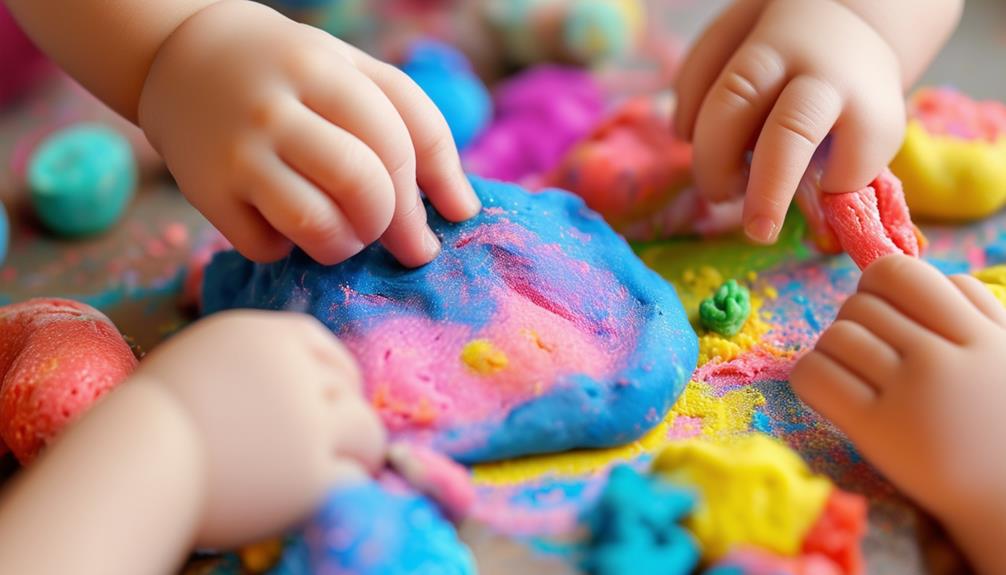
Rolling and pinching playdough can significantly enhance your child's finger dexterity. These activities strengthen finger muscles, thereby improving finger control and fine motor skills. When your child pinches small pieces of playdough, they engage in tasks that enhance finger coordination and precision. This is vital for developing fine motor skills needed in daily activities like writing and buttoning clothes.
Creating intricate designs with playdough further refines finger dexterity. This activity requires finger isolation and manipulation skills, allowing your child to practice moving their fingers independently with greater accuracy.
Using tools like cookie cutters and stamps with playdough introduces diverse finger movements, promoting fine motor development. These tools encourage pressing, pushing, and pulling, all essential for strengthening fingers. Incorporating these activities into playtime provides a fun and effective way for your child to improve their finger dexterity and overall fine motor skills.
Improving Hand-Eye Coordination
Using playdough tools like cookie cutters and molds enhances hand-eye coordination by requiring precise alignment of hand movements with visual input. This activity also boosts spatial awareness as you shape the dough to match specific forms or patterns. By concentrating on these detailed tasks, you improve your ability to synchronize hand movements with what you see.
Utilizing Play Dough Tools
Using play dough tools like rolling pins and cutters significantly enhances your child's hand-eye coordination through precise movements. These tools require focused control of hand movements, thereby improving motor skills. Manipulating rolling pins to flatten the dough or cutters to shape it allows your child to practice aligning their hand movements with visual stimuli.
Engaging with different play dough tools refines your child's dexterity and precision. Tools such as cookie cutters and extruders necessitate the application of appropriate pressure and angle, making them excellent for enhancing hand-eye coordination. These repetitive actions not only strengthen motor skills but also lay the groundwork for more complex tasks.
Incorporating a variety of tools in play dough activities ensures a comprehensive workout for fine motor development. Each tool presents a unique challenge, encouraging adaptation and technique refinement. This hands-on practice is crucial for developing coordination between hands and eyes, ultimately supporting overall motor skills and preparing them for future learning activities.
Enhancing Spatial Awareness
Engaging in playdough activities enhances your child's spatial awareness through tasks requiring precise hand-eye coordination, such as rolling, cutting, and shaping. Manipulating tools like rolling pins and cutters helps improve their fine motor skills and understanding of spatial relationships.
| Activity | Skill Enhanced |
|---|---|
| Rolling dough | Hand-eye coordination |
| Cutting shapes | Spatial awareness |
| Shaping figures | Manipulation skills |
Creating 3D structures with playdough allows children to visualize and understand spatial relationships in a hands-on, tangible manner. This experiential learning is crucial for developing cognitive skills, including problem-solving and visual perception. As they mold and shape the dough, children engage in precise movements that enhance their hand-eye coordination and spatial reasoning.
These activities are both fun and educational, supporting essential skills for daily tasks and future learning. By playing with playdough, children practice the fine motor skills needed for writing, drawing, and even playing sports.
Boosting Creativity
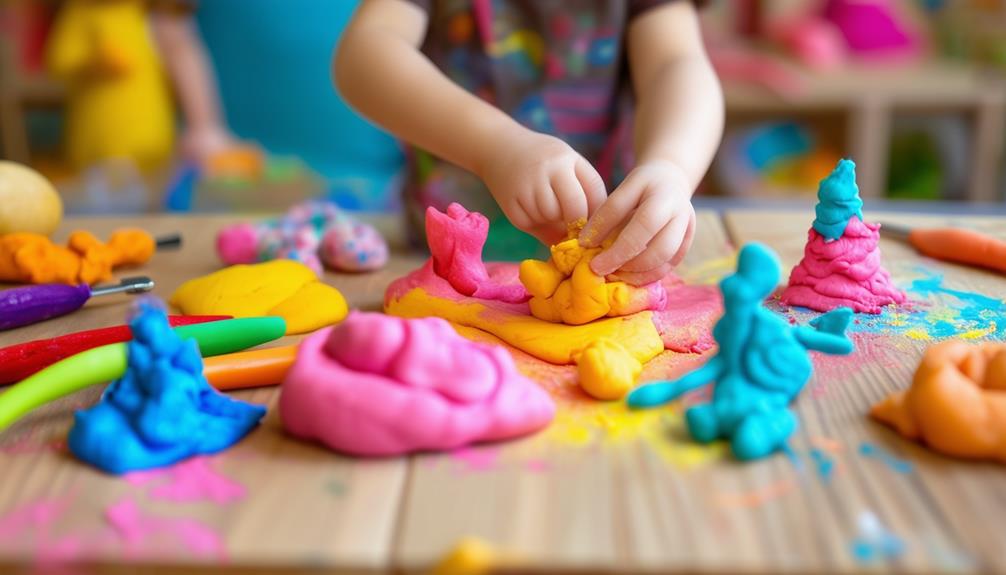
Playdough ignites creativity by allowing kids to imagine and create without boundaries. When children engage with playdough, they dive into a realm of imagination and inventiveness. This versatile material lets them mold, shape, and form anything they envision, transforming simple playdough into a catalyst for creative thinking. Whether they're crafting fantastical creatures, intricate structures, or abstract art, playdough promotes imaginative play in ways few other toys can.
Interacting with playdough enables children to explore shapes and structures, enhancing their problem-solving abilities. They learn to think creatively, devising unique solutions and designs. This hands-on activity encourages self-expression through art, allowing kids to convey their thoughts and emotions in a tangible form.
As children advance from simple creations to more complex designs, their capacity for innovation and collaboration expands. While working on more sophisticated projects, they often share ideas, discuss techniques, and learn from each other's creative processes. This experience not only boosts their creativity but also lays a solid foundation for future collaborative efforts. So, grab some playdough and watch your child's imagination soar!
Social Skills Development
Now, let's explore how playdough can aid in your child's social skills development. Sharing playdough tools and materials fosters teamwork and communication. This collaborative play promotes peer interaction and nurtures empathy.
Encouraging Peer Interaction
Children naturally develop social skills like sharing and teamwork when they engage in playdough activities together. By interacting with peers, they learn to communicate, cooperate, and negotiate—fundamental social skills. When kids gather around a table with playdough, they share tools, exchange ideas, and collaborate on creative projects. This teamwork helps them understand the value of working together and fosters a sense of community.
As they play, children take turns and solve problems collectively, enhancing their ability to empathize with others. For instance, if two children desire the same playdough color, they learn to compromise and find a mutually satisfying solution. These interactions promote empathy and understanding, vital aspects of social development.
Furthermore, playdough play boosts children's self-esteem and confidence in social environments. Successfully completing a project as a team gives them a sense of achievement and pride in their joint efforts. This positive feedback motivates them to interact more with peers, further reinforcing their social connections and abilities. In essence, playdough isn't just a tool for creativity; it's a potent medium for nurturing essential social skills through peer interaction and collaboration.
Promoting Collaborative Play
When children engage in playdough activities together, they naturally practice sharing, teamwork, and effective communication. Collaborative play with playdough fosters social interaction and builds self-esteem through joint creative projects. By working together to create something, children learn to take turns and solve problems—key aspects of social development.
These activities also enhance communication skills. Kids must express their ideas and listen to their peers, promoting understanding and empathy. Discussing what to build or how to share tools helps them articulate thoughts clearly and negotiate effectively.
Moreover, collaborative play with playdough encourages cooperation. Children learn to work as a team, which is crucial for future interactions and relationships. This type of play teaches them to respect others' ideas and feelings, fostering a sense of community.
Emotional Regulation
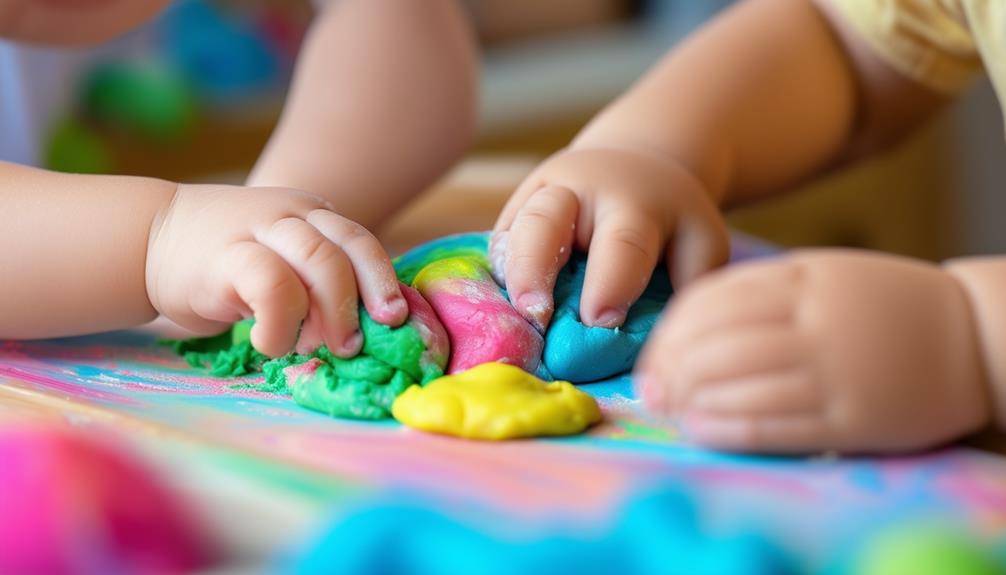
Using playdough can be an effective way to help children calm down and manage their emotions. Engaging with playdough allows kids to release excess energy and ease tension. The simple act of kneading, rolling, and shaping the dough provides a calming and therapeutic experience, especially beneficial for stressed children. This sensory activity helps them focus and concentrate, aiding in emotional regulation.
The tactile experience of manipulating playdough allows children to express their feelings non-verbally. By creating shapes and figures, they can channel their emotions into their play, providing a healthy outlet for frustrations or anxieties. This form of expression contributes significantly to emotional regulation, helping children understand and manage their feelings better.
Additionally, playdough activities support the development of self-regulation skills. As children concentrate on their creations, they learn to control impulses and maintain patience. These skills are crucial for emotional development and have a lasting impact on how they handle stress and emotional challenges in the future. Essentially, playdough isn't just fun; it's a vital tool for emotional well-being.
Literacy and Numeracy
Using playdough can significantly enhance literacy and numeracy skills in young learners. Shaping playdough into letters or spelling out words helps build essential literacy skills, including letter recognition and spelling practice. These activities also support pre-writing skills by improving hand strength and coordination, essential for forming the shapes of letters and numbers, thus preparing children for writing tasks.
Additionally, playdough is a valuable tool for numeracy development. Hiding small objects in the dough for children to find and count introduces basic math operations. Measuring and mixing different colors of playdough can teach concepts such as volume and quantity, making math both engaging and tactile.
Here is a table summarizing various activities and their benefits:
| Activity | Literacy Skills | Numeracy Development |
|---|---|---|
| Shaping letters | Letter recognition | |
| Spelling words | Spelling practice | |
| Counting hidden pieces | Basic math operations | |
| Measuring playdough | Understanding volume | |
| Mixing colors | Predicting outcomes | |
| Forming numbers | Number recognition |
These activities not only promote literacy and numeracy but also make learning an enjoyable, hands-on experience. Incorporating playdough into daily routines sets the foundation for a child's academic success in a playful and creative manner.
Sensory Play Ideas

Playdough offers rich sensory play opportunities that engage a child's multiple senses, supporting both literacy and numeracy. Sensory play with playdough involves touch, smell, and sight, providing a comprehensive sensory experience. Adding aromatic oils can enhance the playdough's appeal by stimulating a child's sense of smell, making the activity more immersive and enjoyable.
Incorporating diverse textures into playdough, such as rice, beads, or grains, can further enrich sensory play. These elements introduce new tactile experiences, allowing children to explore different sensations with their hands. The varied textures not only enhance the sensory experience but also promote sensory investigation and development.
Using scented and textured playdough encourages creativity and sensory engagement in children. As they manipulate the dough, their tactile and olfactory senses are stimulated, aiding in overall sensory development. Creating playdough in different colors and scents keeps the activity fresh and exciting. This multifaceted sensory play not only entertains but also fosters the growth of crucial developmental skills in a fun and interactive way.
Playdough Recipes
Create endless fun with these easy and customizable playdough recipes tailored to every child's preferences. Playdough is a fantastic tool for enhancing fine motor skills and can be easily modified to keep things interesting. Begin with a basic playdough recipe using simple ingredients like flour, salt, water, and cream of tartar—this quick and cost-effective option is perfect for spontaneous play sessions.
For a seasonal twist, try gingerbread playdough. Just add cinnamon, ginger, and nutmeg to your basic recipe to create a delightful scent and color that kids will love. This customized playdough is perfect for holiday-themed activities.
If you're looking for a different texture, the cloud dough recipe is your go-to choice. Made with cornstarch and baby oil, it provides a soft, moldable texture that's excellent for sensory play. For an artistic touch, consider the puff paint recipe. Mix shaving cream, glue, and food coloring to create a unique, textured dough that doubles as a fun painting medium. With these recipes, you can easily customize your playdough to match any child's preferences, making playtime both fun and beneficial for their development.

